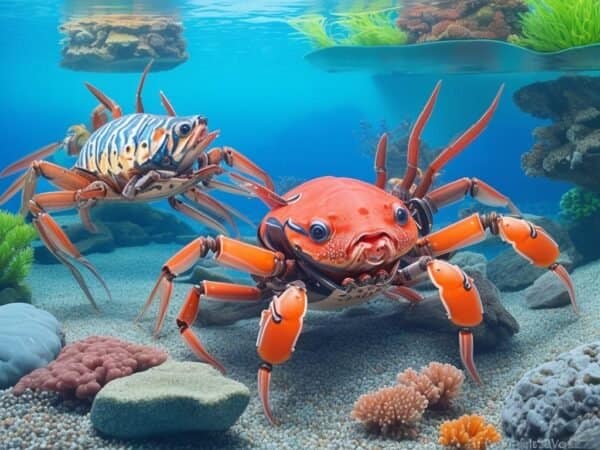Fascinating freshwater aquarium crabs are a unique addition to any tank! They come in all shapes, sizes and colors – a favorite among aquarists. So, where can you find and buy these cute crustaceans? This article will show you the way and give some tips on their care!
If you’re looking to buy freshwater aquarium crabs, you have two options. Firstly, visit a pet store or fish store; they often carry aquatic life, including crabs. Secondly, browse online marketplaces that specialize in aquatic pets and supplies. This way, you can find rarer species.
But before buying, it’s important to check compatibility. Some crab species may be aggressive toward fish or shrimp, while others can coexist peacefully. Research is key; find out the needs and behaviors of each crab species to ensure harmony in your aquarium.
In order to provide suitable habitat and care for your freshwater aquarium crabs, you must maintain a well-filtered tank with regular water changes. Also, provide hiding spots like caves and rocks to create an environment for them to thrive.
As an extra precaution, before introducing new crabs into your tank, quarantine them separately. This will prevent the spread of disease or parasites to your existing tank inhabitants.
Now, you’re ready to find and buy freshwater aquarium crabs that will make a perfect addition to your aquatic ecosystem! Enjoy the hunt!
Understanding Freshwater Aquarium Crabs
These amazing freshwater aquarium crabs range from 0.5 to 2 inches and are native to different regions, including Southeast Asia and South America. They prefer slightly acidic water with temperatures of 72–82 °F and are omnivorous, feeding on algae, detritus, small invertebrates, and commercial crab pellets.
It’s important to remember that these crabs need plenty of hiding spots, such as caves and driftwood, and should not be kept with aggressive tankmates. Additionally, make sure to monitor pH levels and temperature, as well as maintain proper filtration and regular water changes.
Do not collect wild crabs from their natural habitat, as this can harm their ecosystems. Instead, purchase them from trusted aquarium stores or reputable sources to ensure they are healthy and well-adjusted.
Discover the joy of having these fascinating creatures in your own home! Explore the options available for purchasing freshwater aquarium crabs today and create an enchanting underwater world.
Setting Up the Aquarium for Freshwater Aquarium Crabs
To craft the perfect home for freshwater aquarium crabs, take these steps!
- Get Supplies: Gather all the required materials. Get a large tank with a secure lid to stop escape, plus a heater to keep the water temperature right and a filter for proper circulation.
- Substrate and Decor: Select an appropriate substrate, like sand or gravel, that permits burrowing. Add natural elements like rocks, driftwood, and live plants to mimic their natural habitat and give them shelters.
- Water Conditions: Fill the tank with dechlorinated water and watch the pH level, aiming for a slightly acidic to neutral range (6.5–7.5). Maintain the temperature based on your crab species’ needs.
- Acclimation Period: Before adding your crabs, slowly acclimate them. Gradually add small amounts of aquarium water into their transport bag over an hour to help them adjust.
Note: Certain crab species have special requirements. Fiddler crabs need brackish water, while Thai microcrabs prefer heavily planted tanks with lots of hiding spots.
To ensure a healthy habitat for freshwater aquarium crabs, do the following:
- Regular Cleaning: Do regular water changes and clean the tank with a siphon to remove debris. This will help maintain excellent water quality and block any waste buildup that might harm your crabs.
- Feeding: Give a balanced diet of sinking pellets, freeze-dried or frozen foods like bloodworms or brine shrimp, and fresh vegetables like spinach or zucchini slices. Don’t overfeed to avoid polluting the tank.
- Compatibility: Check compatibility between different species before putting them in the same tank. Some crabs can be territorial and aggressive, causing conflict and stress.
By sticking to these tips, you can develop the perfect aquarium for freshwater aquarium crabs. Remember, providing a suitable environment is essential for their health and happiness.
Choosing Freshwater Aquarium Crabs
Adding crabs to your freshwater tank? Think twice! Here are some factors to ponder before picking the perfect ones:
Size matters. Different crab species have varying space needs, so pick those that fit in your tank. Also, note their adult size, as some may grow too big over time.
Compatibility counts. Not all fish and aquatic creatures get along with crabs, so research is needed to find those that cohabit peacefully. Consider their temperaments and behaviors before you buy.
Food for thought. Many crabs are omnivorous, but some have specific dietary needs. Make sure their preferred food lines up with what you can provide.
Care considerations. Some crabs need specific water parameters or hiding spots. Make sure you’re prepared to meet these requirements.
By taking these factors into account, you can create a beautiful and diverse underwater world. Start researching now and get ready to behold the captivating magic of the freshwater crabs!
Where to Find Freshwater Aquarium Crabs
Freshwater aquarium crabs can be found in various places, such as fish stores, online marketplaces, forums, social media groups, and aquatic expos. It’s important to research the needs of each crab species, like sandy or rocky substrates or densely planted tanks.
Sarah, an aquarium enthusiast, spent months on a mission to find a rare Thai microcrabitat crab. She finally found a reputable online retailer that stocked it, and she ordered it with joy. When it arrived, she was delighted to introduce it to its new home.
So if you are an enthusiast, you can have an exciting adventure finding freshwater aquarium crabs, just like Sarah did!
Tips for Buying Freshwater Aquarium Crabs
Freshwater aquarium crabs can add a unique and interesting touch to your aquatic setup. When purchasing these cool critters, keep these tips in mind:
- Species Compatibility: Check if the crab species is compatible with your other fish and creatures.
- Size and Space: Choose a crab size that fits your aquarium.
- Water Parameters: Research the temperature, pH levels and hardness the species needs.
- Health and Condition: Inspect the crabs for signs of disease.
- Sourcing from Reputable Dealers: Buy from a dealer with a good record of providing healthy animals.
Remember to secure the aquarium lid, as some freshwater crabs may escape! For extra advice, consider local fish stores or pet shops that specialize in freshwater aquarium livestock. They usually have knowledgeable staff to help.
Fun Fact: The smallest freshwater crab in the world is the Thai Micro Crab (Limnopilos naiyanetri), reaching a maximum size of 0.8 inches (2 cm)!
Best Practices for Caring for Freshwater Aquarium Crabs
For happy, healthy freshwater crabs, it’s important to pay attention to their needs. Here are some best practices to follow:
- Get the right tank size – 10 gallons is ideal.
- Keep water parameters stable, between 7.0 and 8.0 pH and 72 and 82°F.
- Add a filter for clean water and plenty of hiding spots.
- Feed them a diverse diet with commercial pellets, frozen or live food and fresh vegetables.
- Remove uneaten food from the tank.
- Clean regularly, but avoid chemicals.
Alex’s story is a helpful example: he had a prized crab that became lethargic and stopped eating. He checked the water parameters and found the heater was malfunctioning, causing temperature fluctuations. He replaced the heater and closely monitored it until the crab recovered.
If you want success with your freshwater crabs, remember these best practices!
Conclusion
Bright-colored aquarium crabs can add a unique touch to your tank. They can offer an interesting look and fun behaviors.
You can buy these crabs from various sources.
- Local pet stores usually have them.
- Or, you can search online. There, you can pick from a range of sizes and colors.
Before you purchase these crabs, make sure they will live well with other fish and invertebrates in your tank. Do some research on their needs and temperaments.
Also, you must provide the right habitat for the crabs. Keep the water temperature, pH level, and filtration at the right levels. Also, add hiding spots and structures like rocks or driftwood. This will create a more natural environment.
Frequently Asked Questions
1. Where can I find freshwater aquarium crabs?
Freshwater aquarium crabs can typically be found at pet stores specializing in aquatic animals. You can also check online retailers or local fish clubs.
2. Can I buy freshwater aquarium crabs online?
Yes, you can purchase freshwater aquarium crabs from various online retailers. Make sure to do thorough research on the seller’s reputation and ensure they provide healthy and ethically sourced crabs.
3. Are there specific species of crabs recommended for freshwater aquariums?
Yes, some popular freshwater aquarium crab species include Thai Micro Crabs, Red-Clawed Crabs, and Vampire Crabs. Research their care requirements and compatibility with other tank inhabitants before making a purchase.
4. What should I consider before buying freshwater aquarium crabs?
Prior to purchasing freshwater aquarium crabs, it is important to consider tank size, water parameters, compatibility with other tankmates, and the crab’s specific care needs. Ensure you have the necessary setup to maintain a healthy environment for the crabs.
5. Can freshwater aquarium crabs be kept with other fish?
While some species of freshwater aquarium crabs can coexist with certain fish, not all are compatible. Some crabs may become aggressive towards fish or nip at their fins. It is crucial to research the compatibility of specific crab and fish species to avoid any conflicts.
6. What signs indicate a healthy freshwater aquarium crab?
A healthy freshwater aquarium crab should have all legs intact, a vibrant coloration, and show active and responsive behavior. Look for signs of molting, which is a natural process for crabs to shed and regrow their exoskeletons.

